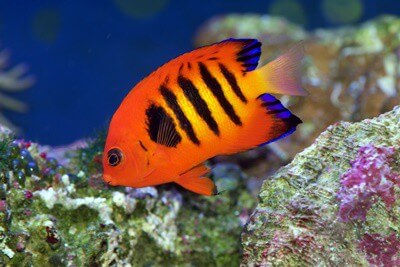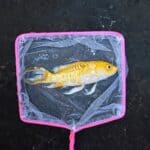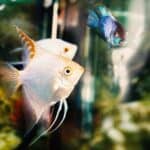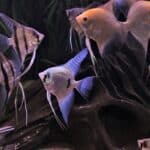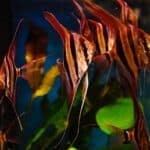Ich is a parasite that can target any fish species. The parasite must be treated with medication to stop its growth and spread. Outside of its newborn stage, ich parasites are immune chemical treatment. As such, medication doses are stretched out over a 2-week period.
Angelfish are more vulnerable to ich than other fish species. If you notice your angelfish are showing signs of ich, chemical treatment will be required. Ich not only causes itchy discomfort, but it can kill your angelfish, if left untreated. The wounds and stress ich cause can lead to secondary infections, decreasing chances of survival even further.
Unlike fungal infections, ich outbreaks don’t start because of low water quality or tank conditions. The parasites are brought into the tank via an infected fish. They may also arrive through plants, water, or ornaments contaminated with cysts that house larvae. So, quarantine new fish and plants in a separate tank before adding them to an aquarium.
Is Fish Ich Fungal or Bacterial?
Ich is neither fungal nor bacterial in nature. Although ich infections are also dubbed white spot disease, ich is actually a parasite called Ichthyophthirius multifiliis. To be exact, it’s an external protozoan parasite, meaning it attaches itself to the angelfish’s body.
Immature parasites burrow into the skin of fish to eat its blood and epithelial cells. These are cells that form a protective barrier on the skin. As you can imagine, this irritates the skin, which triggers the formation of a white cyst. These white spots are the hallmark of an ich infection.
Once the parasite has eaten its fill, it matures into a trophozoite and burrows back out of the angelfish’s skin. The trophozoite, or tomont, forms a sticky, protective mucus bubble. This will sink to the bottom of the aquarium and attach to a surface. In this cyst, the tomont divides and replicates itself.
Depending on the temperature of the water, the tomites will finish growth in days or weeks. At this point, the tomites break free and search for a host. Without your intervention, this cycle will continue. At the least, it will make your fish uncomfortable and even cause long-term pain. At the worst, it will kill the entire tank.
Early Signs Of Ich in Angelfish
Knowing all the signs of an ich infection is crucial for spotting an infection early on and distinguishing it from other diseases.
As a common infection in aquarium fish, people can be quick to assume that any white spot on angelfish is ich. However, there are other ailments with similar visual symptoms.
Ich cysts begin as round spots that can be more concentrated around the gills and fins. Isolated spots appear like grains of sand and are rarely more than 2mm in diameter. In large-scale infestations, these cysts can appear to clump together in masses of lesions. Infestations of this scale are rarely seen early on.
A few isolated cysts are the earliest signs of an ich infection. Monitor the number of these cysts. If they grow overnight to greater numbers, you’ve got an ich problem. Other early signs of ich include:
- The angelfish rubbing itself against objects to alleviate the itchy sensation
- Difficulty breathing
- Gasping an unusual amount, perhaps even at the surface.
Be careful not to misdiagnose gasping. As a single symptom, without the others, it’s far more likely that gasping is a symptom of:
- Ammonia problems
- Low oxygen in the tank

Other Symptoms Of Ich In Angelfish
Aside from white spots, other signs that an ich infestation is in the tank include changed behavior in the fish. They will not only rub to relieve itchy sensations, but also:
- Appear lethargic or unusually subdued
- Hide more often
- Be unwilling to eat
This is a response to stress, poor appetite, and the fish’s system being constantly deprived of the nutrients. After all, the parasites are stealing anything they can. It’s also natural for fish to hide when they feel unwell. This typically appears after a prolonged infection.
Angelfish may also suddenly die. An undetected ich infection ends up being responsible. That’s because ich infections can be contained inside the gills, where you can’t see cysts.
In this case, you have to look for pale and/or swollen gills. Angelfish with concentrated cyst lesions in the gills may also struggle to breathe. In infections that have progressed greatly, you will find:
- Redness
- Swelling
- Bloody streaks or patches on the fish
Remember that these parasites burrow in and out of the skin. Larger infections will develop horrid looking wounds.
How To Get Rid Of Ich In Angelfish
When caught early, treating ich is usually successful and won’t result in any infected angelfish dying. Successful treatment may even result in an exposure-generated resistance to future ich infections, according to Immunological Reviews.
There are a few treatment methods. The best will combine several different methods, which will help you completely eradicate the parasite from the tank. The sooner you begin a treatment plan, the better.
Just keep in mind that treatment is only effective against parasites in the tomite stage of their lifecycle. Freshly hatched parasites are vulnerable, while trophozoite and tomonts are protected by either mucus or a cyst.
Water Changes
Water changes are always a good idea, but especially when treating ich. Be sure to conduct a daily water change of roughly 20% while treatment progresses. It’s even more important to perform water changes when using chemical or medicated treatment options. You don’t want these building up in the tank and overdosing your fish.
Dispose of this water down the drain and sterilize any containers, siphons, or piping you use.
Note that ich parasites are tiny. They can be transferred to other water sources by aerosolized spray or by transferring items between tanks. Be careful not to cross-contaminate.
Medication
A confirmed diagnosis of ich needs medicated treatment. You won’t be able to stop the parasite otherwise. Thankfully, there are multiple treatments available at pet supply stores and aquarium shops. The two medications with the best track records are:
- Ich-X, which is safe for fish (scaleless and not), shrimp, and plants
- ParaGuard, which is a broad-spectrum treatment for parasites, fungi, and bacteria
Be careful to accommodate any tank mates, such as scaleless catfish, which will demand an adjusted dosage. At the minimum:
- Dose the fish for 2 weeks straight
- Continue medication until all symptoms have been resolved and you are certain the parasite is gone
- Follow the instructions for specific dosage rates.
If you use carbon filtration in the tank, remove it. Carbon will strip the chemicals in the medication and render it useless.
Home Remedies
Home remedies can be cheaper and more appealing to some. However, they aren’t very effective when treating ich in angelfish. Given how rapidly ich can progress to lethal levels, it’s advisable to use medicated treatments.
If that isn’t possible, however, then you can combine these two elements for semi-effective treatment:
- Aquarium salt
- Higher temperatures
Aquarium salt is a more natural way to help eliminate ich, but its effectiveness is limited. Using salt and raising the temperature is good for decontaminating the tank. You may have to move the fish to a separate tank for treatment so that you can concentrate the heat and salt levels in a smaller area. Follow the instructions provided on the packaging to determine the amount of salt required.
Note that it’s best not to cross-contaminate aquarium salt with other medicated or chemical treatments. That can have a detrimental effect on the tank.
Aquarium salt is also good as a post-treatment step. The salt can partially purify the water, and help wounds and slime coatings recover. Be sure to incorporate water changes between medicated treatment and aquarium salt treatments. Try not to let the two overlap.
Quarantine Tank
When it comes to the treatment of ich in angelfish, even if only one fish has visible cysts, you should treat all fish in the tank. Some fish may not be presenting cysts yet, but are infected. Others may have cysts inside the gills, where they can’t be seen.
If your aquarium is quite large, medicating the tank properly can be tricky. It may be beneficial to move all of the fish to a smaller quarantine tank for the duration of treatment. If you do this, keep the main tank running and turn up the heat.
This will encourage the cysts housing tomites to hatch. Without a host fish, the larvae will die within a few days. Even if your tank isn’t enormous, this is still a great method for breaking the lifecycle of ich.
Raise Aquarium Temperature
If possible, adjust the temperature of the water in combination with all of the treatments above. The University of Florida points out that the lifespan of ich parasites is dependent on the water temperature. Warmer temperatures cause the vulnerable larvae to hatch quicker. Colder temperatures turn a few days of incubation into a few weeks.
Adjust the temperature so that it sits between 75-79°F. In cases where this isn’t possible, perhaps due to angelfish tank mates, either move the fish to a separate tank or prolong your treatment plan. Essentially, by warming the water, you are shortening the lifecycle of the parasite at all stages. The sooner cysts hatch, the sooner you can break the cycle of reproduction.
You can gradually raise the temperature to 86-89°F and keep it there for 2 weeks. This should kill off any ich parasites. These parasites are intolerant of really warm water. As such, this can be a moderately effective means of culling the population if you dose the tank with aquarium salt too.
There are a few downsides to increasing the temperature this high.
- Be warned that the fish may not be able to tolerate warm water for this length of time.
- Warmer water also has lower oxygen content.
- You will need to add an air stone or otherwise increase the water’s aeration so that the fish don’t suffocate.
- Bacteria, yeast, and fungi thrive in warm waters, and may have outbreaks during this time.
Can Angelfish Survive Ich Without Treatment?
Angelfish will not survive ich without treatment. When left unattended, the parasite populations will continue to grow and re-infect fish until all available hosts are dead. All fish will eventually succumb to ich.
People that claim their fish recovered from ich on their own likely misdiagnosed the original condition.
Can Angelfish Become Immune To Ich?
Veterinary Parasitology has noted that fish can develop a degree of immunity to various parasites. Don’t mistake this for total immunity, however, because it’s not. No fish is completely immune to ich.
Certain species have a natural defense against parasites, including ich, which allows them to withstand an infection for longer. All this means is that a fish will take longer to die, as it can resist the parasites. The ich will not be able to successfully attach to the fish, which means a proper infection takes longer.
Angelfish are more vulnerable to ich than other species of fish. Any stressed fish or ones with compromised immune systems are more susceptible.
How Long Can Angelfish Live With Ich?
How long an angelfish can live with ich depends on the severity of the infection. Heavy infections can cause death within a week or so. Meanwhile, lesser infections in healthy fish can take a month or more to perish. The fish will die, though, without treatment.
In most cases, it is safe to use a 24-48 hour period for diagnosing ich if you aren’t certain if a parasite is responsible.
Is Ich Contagious To Other Fish?
Angelfish don’t directly pass ich from one fish to another via contact or close proximity. That’s not how ich infections work.
Instead, a host angelfish will harbor immature parasites. The offspring will then detach and go on to infect other fish. Ich parasites replicate very quickly, and a single parasite can become 100 in a month’s time.
Is Ich Transferable To Humans?
Thankfully, ich cannot be transferred to humans. However, you should still dispose of contaminated water properly and be sure to wash up after coming into contact with aquarium water. Don’t let your other pets play in or drink the water.
How Long To Quarantine Fish With Ich
If you’ve placed your infected fish in a quarantine tank, how long should it stay there? In most cases, it is recommended to keep a fish in quarantine for 3-5 days after the ich has been eradicated. Depending on your treatment plan and the scale of the infestation, the treatment period will vary by a week or so.
Note that ich infections can weaken the angelfish and make it vulnerable to bacterial or fungal infections. The wounds inflicted and a weakened immune system can cause a secondary infection to spring up. This will have potentially fatal consequences. Allowing the fish time to recuperate in quarantine is helpful, and makes treatment easier if it falls ill again.
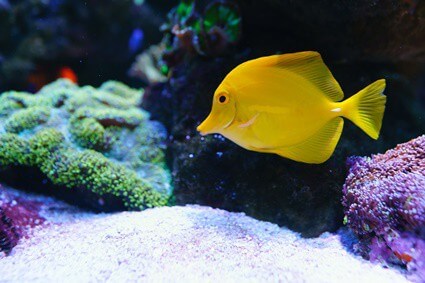
How To Clean Ich Out Of A Fish Tank
If you’ve eradicated the ich, how do you handle all the dead biomass left behind in your tank? Yes, you do need to remove those corpses from the tank, minuscule as they are. As they decompose, these bodies release bacteria and chemicals into the water. This can cause a spike in algae or harmful bacteria colonies.
In general, such spikes cause health problems in fish. For angelfish recovering from an ich infestation, the potential for secondary infections is increased.
- Once you are certain that the parasites are exterminated, thoroughly clean the gravel with a gravel vacuum or siphon.
- Be sure to go over any plants and ornaments as well.
- Continue doing water changes every 1-2 days for a week if you used medication in the aquarium.
How To Prevent Ich In A Fish Tank
Prevention is key when it comes to all manner of angelfish diseases and tank problems. Here’s how to make sure ich doesn’t come back:
Tank Maintenance
Be sure to maintain the aquarium with proper water changes, filtration, and water checks. This will prevent a number of problems from occurring. Ich isn’t like a fungal infection that starts up when water quality is bad.
However, ich outbreaks in such good conditions will be easier to get on top of. Clean tanks also keep your fish healthier, so they will have an increased chance of survival.
Quarantine
Always quarantine new fish or plants in a separate tank. This is your main method for stopping any unwanted disease or parasite from infecting your main aquarium.
A good isolation period is 2-4 weeks. Some suggest a full month. In most cases, any underlying problems will present themselves during this time.
A quarantine tank also makes it easier to treat any problems that do arise. It’s doubly useful when figuring out where the problem has come from. Instead of misdiagnosing your entire tank, you can narrow it down to the new plant or fish.
Choose Carefully
You should also scrutinize where you buy new plants and fish. Only buy healthy fish, and avoid those that are housed with diseased or dead fish.
Also avoid purchasing plants that are kept in a tank with fish if you can. If not, quarantine the plants in a tank without fish for 1-2 weeks. Cysts will attach themselves to anything, including:
- Plants
- Algae
- Moss
Keep Angelfish Healthy
A healthy fish is easier to treat for ich. Provide angelfish with:
- A varied diet of high-quality food
- Minimize stress sources
- Don’t over-crowd the tank
All of these methods will keep the fish in top health. While they won’t kill an ich infection if the parasite arrives in the tank, it will give the fish greater odds of surviving treatment.
Fish Diseases That Look Like Ich
Ich is common in freshwater fish tanks. However, ich isn’t always responsible for odd behavior or white spots on the body. Other ailments have similar symptoms, many of which are parasites or infections that affect the gills.
Stress Ich
Stress ich is triggered, unsurprisingly, by stress. Many white spots appear on the fish’s body. These are stress spots, and will fade once the stressor is removed.
Aside from taking a scraping in for a vet to look at under a microscope, you can diagnose the type of ich by looking at the number of spots. Spots caused by parasitic ich will grow in number over a 24-48 hour period. Stress ich will not.
Other Parasites
Changes in your angelfish’s behavior may also be the result of parasites like:
- Gill flukes
- Fish lice
- Chilodonella
These may cause your angelfish to rub against objects and experience difficulty breathing. Velvet also causes difficulty breathing. These are only a few ailments that have similar symptoms to ich.
If your angelfish appear unwell and you struggle to pinpoint the cause, take photos and water samples to your local aquarium store. They will hopefully be able to diagnose the issue and prescribe a solution.
Angelfish and Ich
Ich is a common parasite. This microscopic creature burrows into the skin of an angelfish and consumes its blood and cells. It rapidly replicates at maturity, turning a single parasite into a swarm in weeks.
As a parasite, it is resilient to treatments in all but one stage of its lifecycle, making treatment a multi-week affair. Not treating ich will result in the death of your beautiful angelfish, as this is a fatal infection.
If you suspect that ich has infected your tank, act fast, as this parasite can quickly infect all fish in the tank, leading to a mass loss in life.

